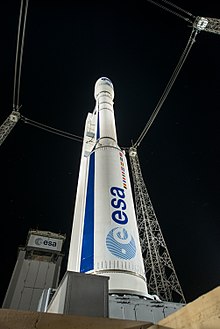
Vega was an expendable launch system in use by Arianespace which was jointly developed by the Italian Space Agency (ASI) and the European Space Agency (ESA). Development began in 1998 and the first launch took place from the Guiana Space Centre on 13 February 2012.[1]
It is designed to launch small payloads — 300 to 2,500 kilograms (660 to 5,510 lb) satellites for scientific and Earth observation missions to polar and low Earth orbits.[2] The reference Vega mission is a polar orbit bringing a spacecraft of 1,500 kilograms (3,300 lb) to an altitude of 700 kilometres (430 mi).
The rocket, named after the star Vega,[3] is a single-body launcher (no strap-on boosters) with three solid rocket stages: the P80 first stage, the Zefiro 23 second stage, and the Zefiro 9 third stage. The upper module is a liquid rocket called AVUM. The improved version of the P80 stage, the P120C, is also used as the side boosters of the Ariane 6. Italy is the leading contributor to the Vega program (65%), followed by France (13%).[4] Other participants include Spain, Belgium, the Netherlands, Switzerland and Sweden.[5]
- ^ "Vega". ESA. 3 February 2012. Retrieved 14 February 2012.
- ^ Amos, Jonathan (13 February 2012). "Vega launcher makes first flight". BBC News. Retrieved 13 February 2012.
- ^ Tariq Malik (13 February 2012). "Europe Launches New Vega Rocket on Maiden Voyage". Space.com. Retrieved 29 May 2014.
The Italian-built Vega rocket is named after the second-brightest star in the northern hemisphere
- ^ Svitak, Amy (6 February 2012). "European Vega Small-Class Launcher Targets Government Market". Aviation Week. Retrieved 11 March 2010.
- ^ Clark, Steven (14 February 2012). "Vega launcher program courts German participation". Spaceflight Now. Retrieved 14 February 2012.